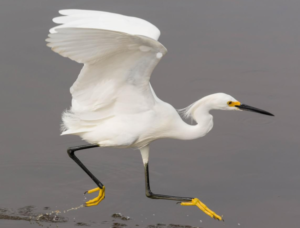
- Appearance:all white feathers, black bill, patch of yellow skin around eyes, S-shaped neck, black legs with yellow feet – also known as the “yellow-footed egret”
- During breeding season has long, lacy feathers along neck and back – “aigrettes”
- Males are larger than females, but coloration is similar, both grow aigrettes

- Height:about 24 inches (2 feet)
- Wingspan:about 40 inches (3.25 feet)
- Status:common
- Nearly hunted to extinction during 1800s during the feather trade – in 1886 aigrettes were valued at $32 per ounce ($850 today), which was twice the price of gold at the time
- Around 1910, feather trade was ended by conservationists
- Since then, populations have recovered and even extended their range
- Threats to snowy egrets still exist, such as habitat loss
- Nearly hunted to extinction during 1800s during the feather trade – in 1886 aigrettes were valued at $32 per ounce ($850 today), which was twice the price of gold at the time
- Habitat
- Estuaries, saltmarshes, tidal channels, shallow bays, mangroves, saltwater lagoons, freshwater swamps, and grassy ponds
- Prefer saltwater habitats to freshwater habitats
- More than 100 million acres of wetlands in the U.S. have been drained since colonial times (when total wetland area was estimated at 127 million acres) – this is why snowy egrets have been expanding range
- Found along east and west coasts of United States, Central America, South America, and Atlantic oceanic islands (Cuba, Caribbean)
- Estuaries, saltmarshes, tidal channels, shallow bays, mangroves, saltwater lagoons, freshwater swamps, and grassy ponds
- Diet
- Active during the day, spend large portion of time foraging
- Eat mostly aquatic animals, including fish, frogs, worms, crustaceans, and insects
- Forage on beaches, and in saltmarsh pools, shallow reefs, tidal channels, tidal flats, freshwater marshes, swamps, ocean inlets, wet fields, ponds, and lake edges
- Wade in shallow water, use yellow feet to probe mud or paddle water to find prey
- Strike prey with beak while standing, walking, running
- Sometimes even forage while hovering
- Other water birds often assemble around them to form mixed-species groups
- Migration
- Migrate to breeding grounds in March, leave for wintering grounds in September
- Breeding populations are found in Long Island during summer
- Snowy egrets that breed on west coast U.S. migrate to Mexico
- Snowy egrets that breed on east coast U.S. migrate to Gulf Coast, oceanic islands, and Central America, travel as far as northern South America
- Cruising speed is 20-25 miles per hour, top speed is about 35 miles per hour
- Nesting
- Nest in isolated areas free of potential predators: barrier islands, dredge-spoil islands, salt marsh islands, swamps, and marshes
-
- Nests usually woven on top/outer branches of a woody vine, shrub, or tree
-
- Nesting location often changes from year to year
- Males choose nesting territory and site within a breeding colony (“rookeries”)
- Colonies can contain various species of egrets, herons, ibises, and spoonbills and can consist of hundreds of breeding pairs
- When males display for females, the skin around their eyes turns red and their yellow feet turn red-orange
- Male starts nest before finding female, then female takes over and male brings materials: twigs, small sticks, grasses, sedges, rushes, and mosses
- Average brood is 2-6 pale blue-green eggs
- Males and females take turns incubating eggs
- Both parents feed hatchlings, those that hatch last may be outcompeted by their siblings in time of food shortage
- Hatchlings have black-tipped, yellow beaks that fade to black over next 5 weeks
- Juveniles leave nest after about 2 weeks and learn to hunt
- Fledglings learn to fly after about 30-40 days
- Snowy egrets sometimes mate with other species and produce hybrid offspring (tricolored herons, little blue herons, and cattle egrets)
- Average lifespan is about 8-12 years, oldest snowy egret was about 18 years old
- Nest in isolated areas free of potential predators: barrier islands, dredge-spoil islands, salt marsh islands, swamps, and marshes






